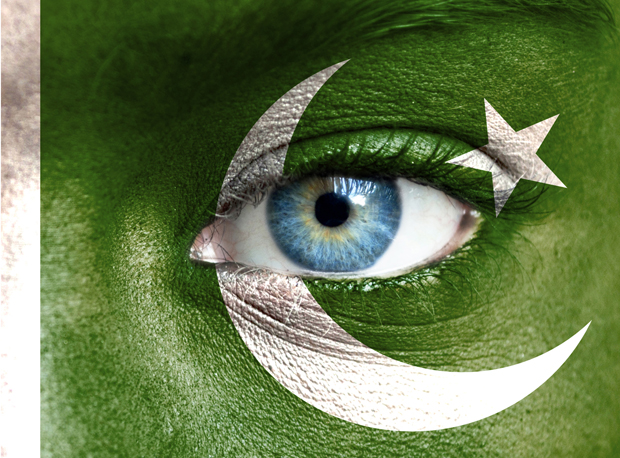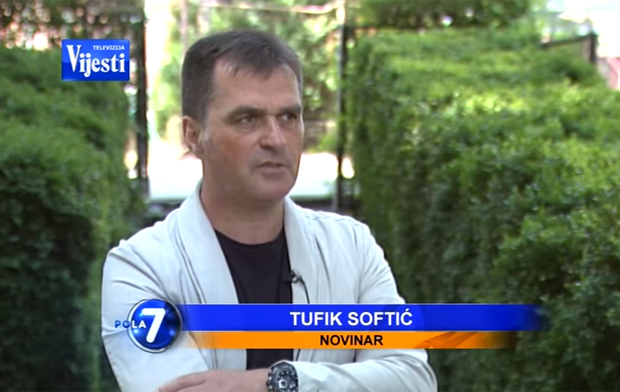29 Jul 2014 | Asia and Pacific, News and features, Pakistan

(Image: Aleksandar Mijatovic/Shutterstock)
In March, Pakistani columnist Raza Rumi was injured in a gun attack that killed his driver. Weeks later, Hamid Mir, star journalist of Geo TV, Pakistan’s biggest TV station, was shot six times. Luckily, both survived, and managed to avoid becoming part of a bleak statistic: Since 1992, 30 journalists have been murdered in Pakistan; 28 with impunity.
Against this backdrop, a group of experts on Pakistan and its media came together, under the auspices of the Commonwealth Journalists Association and the Institute of Commonwealth Studies at the University of London to discuss the threats facing the country’s journalists. In a discussion chaired by BBC presenter Owen Bennett Jones, former High Commissioner of Pakistan Wajid Shamsul Hasan, Kiran Hassan of the International Institute of Strategic Studies, BBC Urdu Service Editor Aamer Ahmed Khan, New York Times Pakistan Bureau Chief Declan Walsh and renowned journalist and author Babar Ayaz tried to answer the question, How safe is it to be a journalist in Pakistan?
Censorship in Pakistan used to be straightforward, explained Khan. Certain topics were simply off limits. Today, the situation is more complicated and more confusing. Threats to journalists and press freedom take many different shapes, and come from many different sources, including the government, extremists like the Taliban, the intelligence service ISI and powerful media owners.
There are currently 84 different cases against Geo TV, of which 53 are over blasphemy. You cannot defend yourself against that, said Khan. Ayaz raised a similar point when arguing that extremists are the biggest threat to the media. The government might put a person in jail, but these extremist groups will kill for their beliefs, Ayaz said.
While Geo TV and ISI have long been fighting behind closed doors, the case of Hamid Mir created an “open battlefield”, explained Walsh, who was expelled from Pakistan in May 2013. The station aired reports linking the security services to the attack.
Walsh also brought up the ownership issue within the Pakistani television landscape, which he says has gone from “zero to 100” in the past few years. The country today boasts some 90 TV stations. Editorial control remains with media owners, according to Hassan.
But even journalists themselves did not escape criticism. Sections of the media are responsible for the current situation through irresponsible reporting, said Hasan. Quite a few were “playing with fire” by earlier glorifying the Taliban as peacemakers, he explained. Khan also highlighted corruption within the media as a “novel form of censorship”. However, as Khan pointed out, it is difficult for the Pakistani media to be responsible, without enabling them to be responsible. Most of the information that effects people’s lives is under strict control by authorities, he said.
Hassan, however, argued that there has been some progress. Journalists, and by extension the threats they face, are more visible and garner more attention today. She also pointed out that despite part closures, all Pakistan’s TV stations are still running. There was some talk of the role of media regulation in improving the situation, and Hassan said she had hopes for Pembra, the Pakistan Electronic Media Regularity Authority.
Yet, the overall conclusion was that Pakistan is not a safe place to be a journalist — illustrated well by Walsh explaining how, for the first time since he’s covered Pakistan, The New York Times recently had to use a pseudonym to protect their reporter on the ground.
Hasan summed it up: “The establishment doesn’t want the media to be as free as it can be.”
This article was published on July 29, 2014 at indexoncensorship.org
29 Jul 2014 | Draw the Line, Press Releases
Index on Censorship was invited to join a meeting of the Lewisham Young Advisers to talk about our Draw the Line programme and discuss “Can art or journalism ever be terrorism?” and how the right to free speech affects every area of our lives.
The group dove straight into discussions of how, as a society, we should all have the right to free speech, but by voicing your opinions or beliefs there is the risk off offending others, so where do you draw the line? Another example offered by the group was exercising your right to free speech through voting and how non-voters can’t complain about a government if they don’t exercise their right to vote in elections.
The debate swiftly moved into this month’s Draw the Line topic, “Can Art or Journalism ever be terrorism?” The group mostly agreed that a piece of art of a piece of journalism could not be considered terrorism, but raised the question “what defines terrorism?” If it just included an act of violence in pursuit of political ideals then it couldn’t be, but at the same time wasn’t a film or a piece of writing capable of inciting hatred? And couldn’t this lead to acts of destruction? The group suggested that although this was true that it was more likely that this person already held these ideas or at least had the capacity to be violent.
The discussion showed that there is no easy answer to these questions, but it is important to keep having these debates and continuing the discussion of ideas to hear the different sides of every idea.
Get involved with the debate and let us know what you think about ‘Can art of journalism ever be terrorism?’ by tweeting using the hashtag #IndexDrawtheLine.
Lewisham’s Young Advisers are a group of young people who are interested in politics or getting involved in the community. Young advisers have a direct involvement in the process of determining council grant allocation to youth service initiatives, experiencing some of the real complexities of political decision-making and public service delivery.
28 Jul 2014 | Awards, News and features, Rwanda, Tanzania, Uganda
Playwright David Cecil was nominated for an Index on Censorship Freedom of Expression Arts Award 2014 after Ugandan authorities deported him from the country for producing a “pro-gay” play in 2013. Determined to continue his work in the Africa, Cecil is now focusing his attention on film production and education in East Africa. With one film school already set up in Uganda, he spoke to Index about his hopes to expand the project to Rwanda and Tanzania, why he believes film in Africa is going to take off in a big way over the coming years and how the situation for LGBT people in Uganda has deteriorated over recent months.
25 Jul 2014 | Mapping Media Freedom, Montenegro, News and features

Seven years after the brutal attack that nearly took the life of journalist Tufik Softic, Montenegrin police detained two men suspected of involvement of his attempted murder. For media unions and observers, the detentions were long overdue, but emblematic of the atmosphere of impunity in Montenegro.
According to police, the men — VL and IA — were arrested in Budva on 17 July and charged with attempted murder in the 2007 attack on Softic, a reporter for the opposition daily newspaper Vijesti. After questioning by the state prosecutor, who confiscated their passports, the men were released the same day. Minister of Interior Rasko Konjevic also issued a statement on the case.
In November 2007, Softic was brutally beaten in front of his home by two hooded assailants wielding baseball bats. Then in August 2013, an explosive device was thrown into the yard of Softic’s family home. The journalist has been provided constant police security since February 2014.
OSCE Representative on Freedom of the Media Dunja Mijatovic welcomed the arrest of the two suspects for the attack on Softic. She also urged, “authorities of Montenegro to persist until all attacks on journalists, especially the murder of Dusko Jovanovic in 2004 are resolved and the perpetrators and masterminds are brought to justice”.
Journalists, the Media Union and NGOs emphasize that the atmosphere of impunity that has been created in Montenegro concerning attacks on journalists is the biggest threat to media freedom. The groups put the responsibility for the climate on authorities.
NGO Human Rights Action (HRA) highlighted the perilous state of journalism in their report Prosecution of Attacks on Journalists in Montenegro. The HRA outlined 30 cases of threats, violence and assassinations of journalists as well as attacks on media property between May 2004 and January 2014.
“Most of these attacks have not been clarified to date. In most cases certain patterns can be observed, for example: victims are the media or individuals willing to criticize the government or organized crime,” said the report.
One-third of all the incidents happened in the last year. For HRA, this is clear evidence that the atmosphere of impunity is escalating and inviting more attacks on journalists.
“Such an atmosphere of impunity threatens journalists in particular, who are often victims of unresolved attacks. If the state treats these attacks passively, it becomes responsible for the suppression of freedom of speech, the rule of law and democracy”, the group reported.
The European Parliament issued a resolution on the 2013 progress report on Montenegro expressed “grave concern about the increase in verbal and physical intimidation of journalists,” and “calls for all threats and attacks against journalists to be adequately investigated and prosecuted, including unresolved previous offences.”
UN Special Rapporteur on the promotion and protection of the right to freedom of opinion and expression, Frank La Rue, undertook an official visit to Montenegro from 11 to 17 June 2013. In the report that followed, he recommended that “the identification of responsibilities in all cases of violence and intimidation against journalists must be achieved without delay, so perpetrators are brought to justice.”
That police needed seven years to question any suspects in the brutal assault on Softic “could be used as an indicator of effectiveness and dedication of the police in resolving these cases”, underlined Marijana Camovic, chief of the Montenegrin Media Union. “Yes”, she said, “we welcomed the detention of two suspects, but let’s have in mind that this is just one of the many cases that need to be resolved.”
For the Media Union, it is a common occurrence for criminals and people with political ties to threaten, berate and attack journalists. “Nowadays journalism is the most dangerous profession in Montenegro and that is why we need extra protection,” said Camovic.
Human Rights Action has proposed the introduction of two new and amendments to criminal offenses: “Grave types of murder” and “Serious bodily injury” with the aim of increased protection for journalists in performing professional duties. In the same manner, the Media Union is advocating for similar amendments so journalists could have protection under the law on a par with police officers.
In December 2013, the Montenegrin government established a commission for monitoring actions of authorities in the investigation of cases of attacks on journalists. As a result of their work, in January 2014, Dusko Markovic, a deputy prime minister and justice minister, was questioned because it was alleged that he withheld information on the murder of Dusko Jovanovic, the editor-in-chief of the opposition newspaper Dan, in 2004. Montenegrin media reported that Markovic was the head of the secret service at the time.
More reports from Montenegro via mediafreedom.ushahidi.com
Arson attack on vehicles owned by Montenegrin daily
Politician and journalist discredit TV station
This article was posted on July 25, 2014 at indexoncensorship.org


